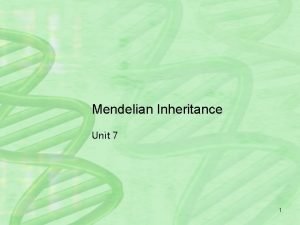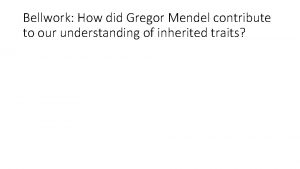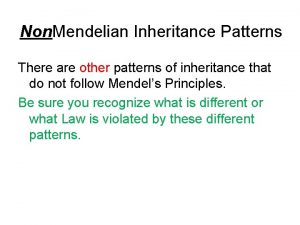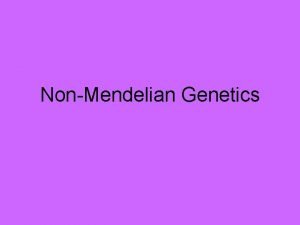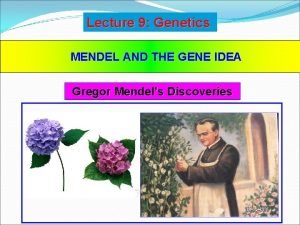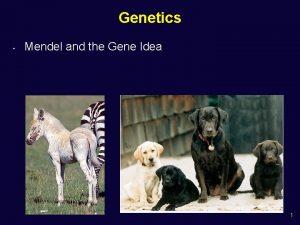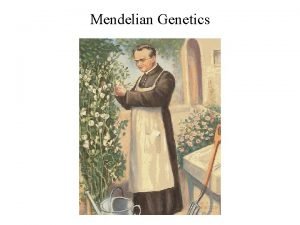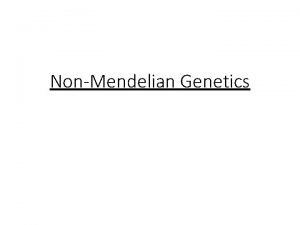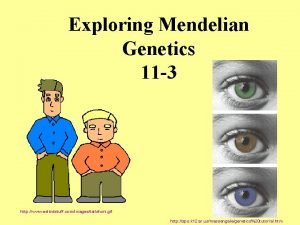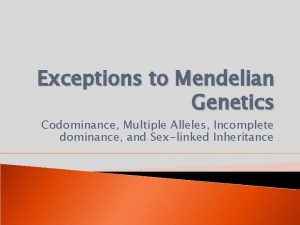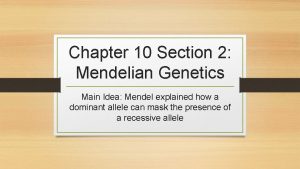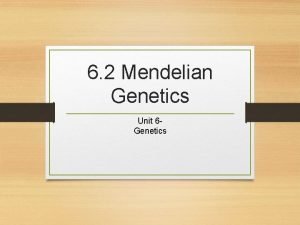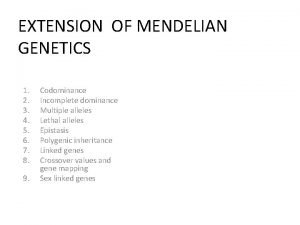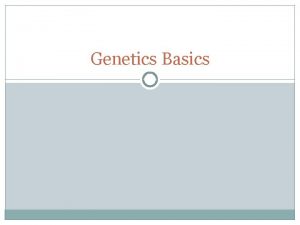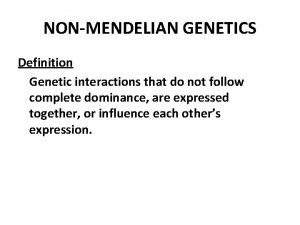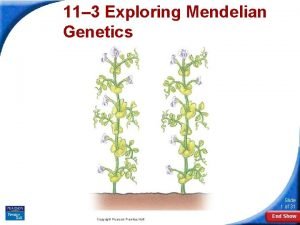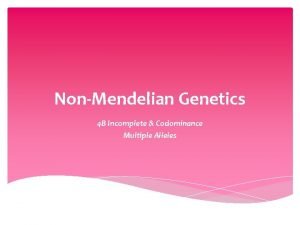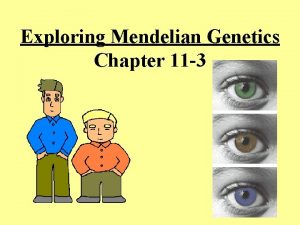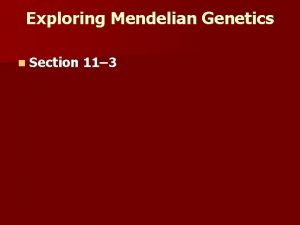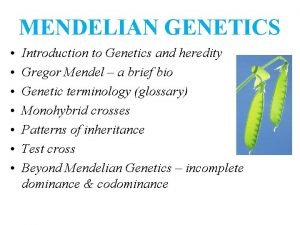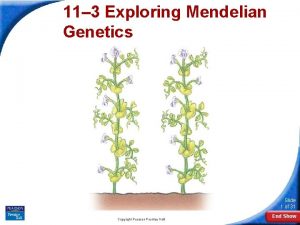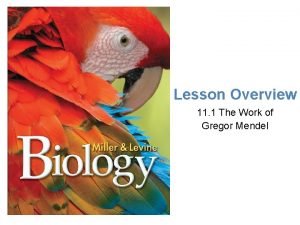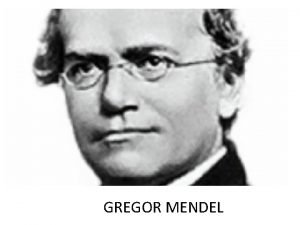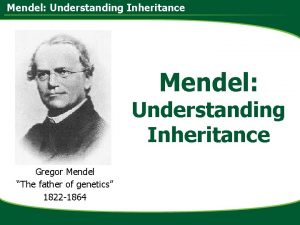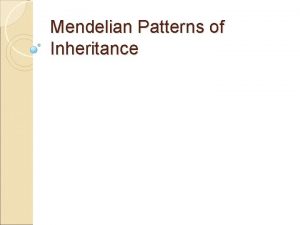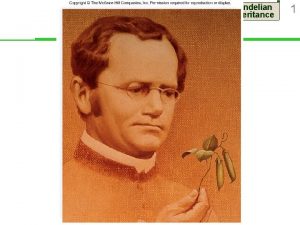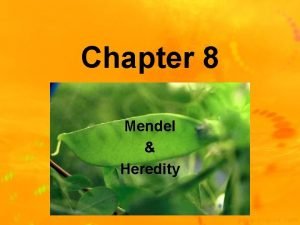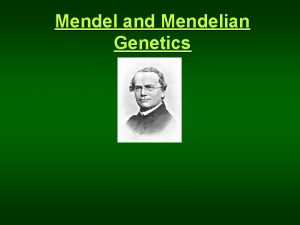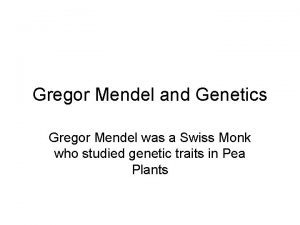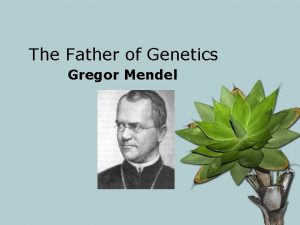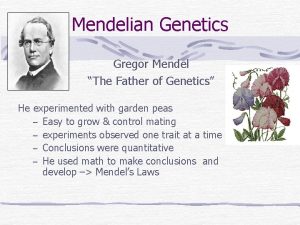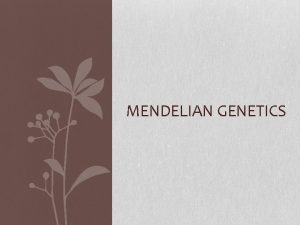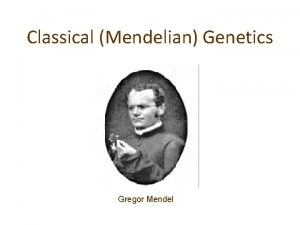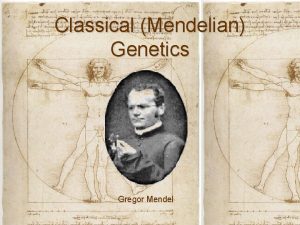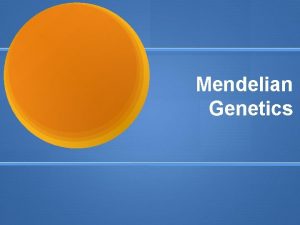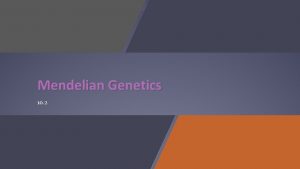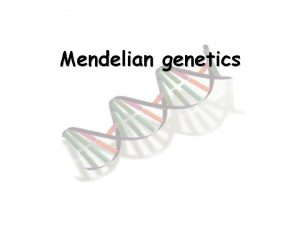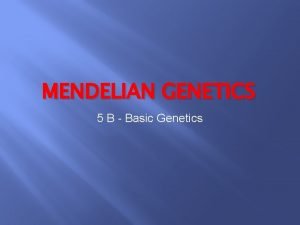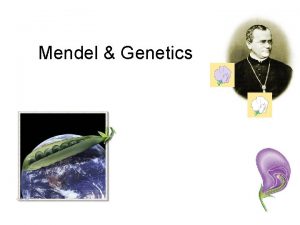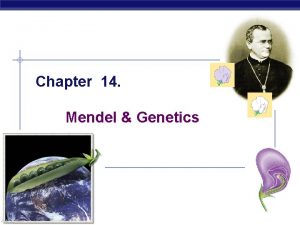Mendelian Patterns of Inheritance Gregor Mendel Genetics is





































- Slides: 37

Mendelian Patterns of Inheritance

Gregor Mendel Genetics is the study of heredity. Mendel was an Austrian monk who studied genetics in the 1860 s using garden peas. ◦ Had no knowledge of cells or chromosomes. ◦ Did not have a microscope.

Mendel knew that… Each male flower part produced pollen (sperm) Each female flower part produced egg cells.

Fertilization: During sexual reproduction, when sperm and egg cells join to produce a new cell. Pea flowers are self-pollinating. ◦ The seeds produced from self-pollination inherit all of their characteristics from the single “parent”.

Cross-Pollination �Mendel had truebreeding plants, that when allowed to selfpollinate, would produce identical offspring to themselves �Cross Pollination ◦ Mendel was able to produce seeds that had 2 different parents, each with different characteristics.

Genes and Dominance Trait = a specific characteristic that varies from one individual to the next. ◦ Examples: Height, Eye Color, Skin Color Mendel studied seven pea plant traits, each with two contrasting characters. He crossed plants with each of the seven contrasting characters and studied their offspring.

Theories of Inheritance �Theories time: of inheritance in Mendel’s ◦ Based on blending ◦ Parents of contrasting appearance produce offspring of intermediate appearance �Mendel’s this findings were in contrast with ◦ He formulated the particulate theory of inheritance ◦ Inheritance involves reshuffling of genes from generation to generation

Mendel’s F 1 Crosses on Pea Plants

Mendel’s first Conclusion Mendel's first conclusion was that biological inheritance is determined by factors that are passed from one generation to the next. Today, scientists call the factors that determine traits genes.

Alleles Each of the traits Mendel studied was controlled by one gene that occurred in two contrasting forms that produced different characters for each trait. The different forms of a gene are called alleles.

Mendel’s Second Conclusion � Mendel’s second conclusion is called the principle of dominance. � The principle of dominance states that some alleles are dominant and others are recessive.

Segregation ◦ ◦ Mendel crossed the F 1 generation with itself to produce the F 2 (second filial) generation. The traits controlled by recessive alleles reappeared in one fourth of the F 2 plants.

Segregation P Generation Tall Short F 2 Generation F 1 Generation Tall Copyright Pearson Prentice Hall Tall Short

Segregation • Each individual has a pair of factors (alleles) for each trait • The factors (alleles) segregate (separate) during gamete (sperm & egg) formation • Each gamete contains only one factor (allele) from each pair • Fertilization gives the offspring two factors for each trait


Modern View of Genetics Each trait in a pea plant is controlled by two alleles (alternate forms of a gene) Dominant allele (capital letter) masks the expression of the recessive allele (lowercase) Alleles occur on a homologous pair of chromosomes at a particular gene locus ◦ Homozygous = identical alleles (AA or aa) ◦ Heterozygous = different alleles (Aa)

A capital letter represents the dominant allele for tall. A lowercase letter represents the recessive allele for short. In this example, T = tall t = short

Genotype vs. Phenotype � Genotype ◦ Refers to the two alleles an individual has for a specific trait ◦ If identical, genotype is homozygous ◦ If different, genotype is heterozygous � Phenotype ◦ Refers to the physical appearance of the individual

Punnett Squares �Table listing possible genotypes resulting from a cross. ◦ All possible sperm genotypes are lined up on one side ◦ All possible egg genotypes are lined up on the other side ◦ Every possible zygote genotypes are placed within the squares


Monohybrid Cross Only looks at one trait. Punnett square contains 4 boxes. Individuals with recessive phenotype always have the homozygous recessive genotype However, individuals with dominant phenotype: ◦ May be homozygous dominant, or ◦ Heterozygous

Monohybrid Test Cross Used to determine the genotype of an individual showing the dominant phenotype. Cross the organism with the undetermined dominant genotype with an organism with the recessive genotype.

Example Test Cross �Suppose in humans, tongue-rolling is a dominant trait…we will represent it with a T. �We want to find the genotype of a man who can roll is tongue. ◦ He could be TT…or Tt. �To test this, we would perform a cross between him and an individual who cannot roll their tongue. (tt)

Dihybrid Cross Predicts outcomes of a cross looking at 2 traits at the same time. ◦ Example: Flower height and color, Hair color and eye color. Punnett Square contains 16 boxes.

Law of Independent Assortment Genes for different traits are inherited independently of each other. What does this mean? ◦ Things like eye color and hair color are not “linked” or inherited together. Just because you inherit blue eyes from your mom does not mean you will also inherit her blonde hair.

Example In pea plants, Round Seeds ( R) are dominant to Wrinkled Seeds (r) and Yellow Seeds (Y) are dominant to green seeds (y)

Practice Problem In humans, Brown hair (H) is dominant to Blonde hair (h) and Brown eyes (B) are dominant to Blue eyes (b). Create a punnett square crossing parents who are both heterozygous for both traits.

Exceptions to Mendel’s Rules Incomplete Dominance Co-Dominance Multiple Alleles Polygenic Traits

Incomplete Dominance When one allele is not completely dominant over the other. The heterozygous genotype shows a BLEND of the two homozygous phenotypes.

Example

Codominance Both alleles contribute to the phenotype. ◦ In certain varieties of cows, the allele for a brown coat is codominant with the allele for a white coat. ◦ Heterozygous cows look like:

Multiple Alleles More than 2 possible alleles exist for a single gene. An individual cannot have more than 2, but there are more than 2 possible alleles that can combine together. ◦ I. E. Not just a dominant and a recessive.

Example In blood typing, there are 3 alleles: ◦ A (IA), B (IB), and O (i). The combination of 2 alleles that each individual person has, determines their blood type.

Blood Type Genotype Can Receive Blood From A IA I A A or O B IA i IB IB IB i B or O AB IA IB A, B, AB, or O O ii O

Polygenic Traits �Traits gene. controlled by more than one ◦ Example: Skin Color.

Aa. Bb. Cc aabbcc 20/64 Fraction of progeny 15/64 6/64 1/64 Aabbcc Aa. Bb. Cc AABBCc AABBCC

Sex-linked Traits Normally carried on the X Chromosome. Females = XX Males = XY
 Family resemblance test
Family resemblance test Pp
Pp Gregor mendel’s principles of genetics apply to
Gregor mendel’s principles of genetics apply to How did gregor mendel contribute to genetics
How did gregor mendel contribute to genetics Mendelian inheritance patterns
Mendelian inheritance patterns Mendel experiments in plant hybridization
Mendel experiments in plant hybridization Non mendelian inheritance
Non mendelian inheritance Mendelian inheritance
Mendelian inheritance Cystic fibrosis mendelian inheritance
Cystic fibrosis mendelian inheritance Dominant or recessive
Dominant or recessive Probability laws govern mendelian inheritance
Probability laws govern mendelian inheritance Non mendelian genetics multiple alleles
Non mendelian genetics multiple alleles Eslkidstuff
Eslkidstuff Hors xnxn
Hors xnxn Chapter 10 section 2 mendelian genetics
Chapter 10 section 2 mendelian genetics Carrier female genotype
Carrier female genotype Mendelian genetics
Mendelian genetics Holandric genes
Holandric genes Section 11-3 exploring mendelian genetics answer key
Section 11-3 exploring mendelian genetics answer key Chapter 7 extending mendelian genetics
Chapter 7 extending mendelian genetics Mendelian genetics punnett square
Mendelian genetics punnett square Mendelian genetics vocab
Mendelian genetics vocab Mendelian genetics concept map
Mendelian genetics concept map Pprr x pprr punnett square
Pprr x pprr punnett square An introduction to mendelian genetics
An introduction to mendelian genetics Pleiotropism
Pleiotropism 11.3 exploring mendelian genetics
11.3 exploring mendelian genetics Codominance definition
Codominance definition Mendelian genetics vocabulary
Mendelian genetics vocabulary Section 11-3 exploring mendelian genetics answer key
Section 11-3 exploring mendelian genetics answer key Section 11-3 exploring mendelian genetics
Section 11-3 exploring mendelian genetics Extending mendelian genetics
Extending mendelian genetics Codominance example
Codominance example Section 11-3 exploring mendelian genetics
Section 11-3 exploring mendelian genetics Suit separate
Suit separate Gregor mendel
Gregor mendel Gregor mendel
Gregor mendel Gregor mendel
Gregor mendel
